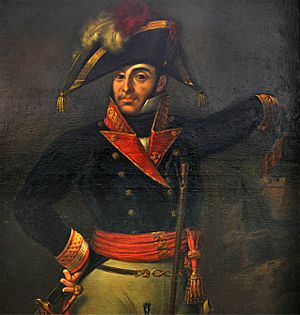Rafael Menacho facts for kids
Quick facts for kids
Rafael Menacho
|
|
|---|---|

Portrait of Menacho, Museum of the Cortes de Cádiz
|
|
| Born | 22 May 1776 Cádiz, Andalusia |
| Died | 11 March 1811 (aged 34) Badajoz, Extremadura † |
| Allegiance | |
| Battles/wars | Peninsular War |
Rafael Menacho y Tutlló (1766–1811) was a brave Spanish military leader. He fought during a big conflict called the Peninsular War. Sadly, he died while fighting in 1811. This happened during the first siege of Badajoz.
Contents
Rafael Menacho's Early Life and Career
Rafael Menacho was born in the city of Cádiz, Spain. He went to a special military school in El Puerto de Santa María. In 1784, when he was young, he joined the Victoria Infantry Regiment as a cadet. A cadet is like a student training to be an officer.
He stayed with this regiment for ten years. His unit was based in Valencia. When the war against France started in 1793, he really wanted to fight. He asked three times to be sent to the battlefield. Finally, he got to fight during a retreat in Argelès. He was seriously hurt there.
In 1795, he moved to a different group called the Voluntarios de Cazadores de la Corona. He fought in several battles in Portugal with them.
Menacho and the Peninsular War
The Peninsular War was a major conflict in Europe. It involved Spain, Portugal, and the United Kingdom fighting against Napoleon's French Empire.
When this war began, Menacho and his regiment joined the army of General Pedro Agustín de Echevarri. This was on July 1, 1808. A few days later, his group joined General Castaños's lead forces.
The next week, Menacho was put in charge of the lead group for Lieutenant General Manuel de la Peña's division. He fought bravely with this group in the important Battle of Bailén.
In September 1810, Menacho was promoted. He became a field marshal, which is a very high military rank. He was also made the military and civil governor of Badajoz. This meant he was in charge of both the army and the city's government. He also commanded the soldiers stationed there.
The Siege of Badajoz (1811)
At the start of 1811, about 4,100 soldiers were defending Badajoz. Before General Mendizábal left for Portugal, he added two more groups of soldiers. This brought the total Spanish troops in Badajoz to 5,000.
After Mendizábal's army was defeated at the Gebora, many of his remaining soldiers came to Badajoz for safety. This included about 1,100 men from La Carrera's division. Another 550 men from Virues's division also arrived. Plus, nearly 1,000 men from Garcia's division joined them. This made the total number of troops defending Badajoz over 8,000.
On March 3, Menacho ordered his soldiers to make a surprise attack. They went out and disabled twelve enemy cannons that were close to the city. While Menacho was watching this action from the castle walls, he was hit by a random shot. He died from this injury.
A week later, the new commander, Brigadier José Imaz, held a meeting with his officers. They decided to surrender the city to the French general, Mortier.
Why Menacho's Death Mattered
A historian named Charles Oman wrote about the Peninsular War. He was very critical of the decision to surrender Badajoz after Menacho died.
Oman believed that if Menacho had lived, the city would have held out much longer. He noted that Badajoz had enough food for 8,000 soldiers for over a month. It also had more than 150 working cannons and plenty of gunpowder.
Oman thought that if Menacho had still been alive, the city would have waited until British forces arrived. General Beresford was ordered to come help on March 12. He would have reached Badajoz by March 18. This suggests that Menacho's leadership was key to the city's defense.
See also
 In Spanish: Rafael Menacho para niños
In Spanish: Rafael Menacho para niños

